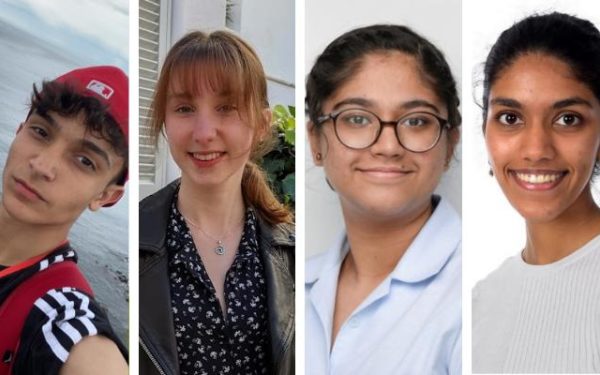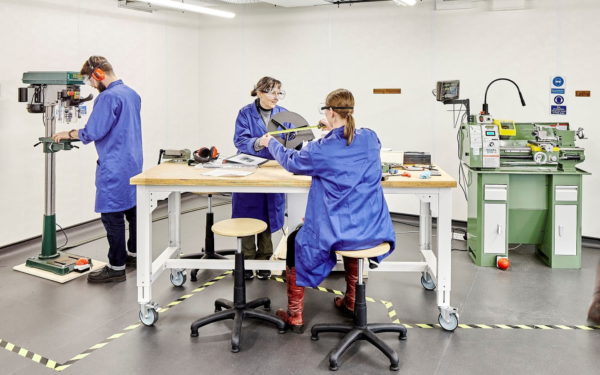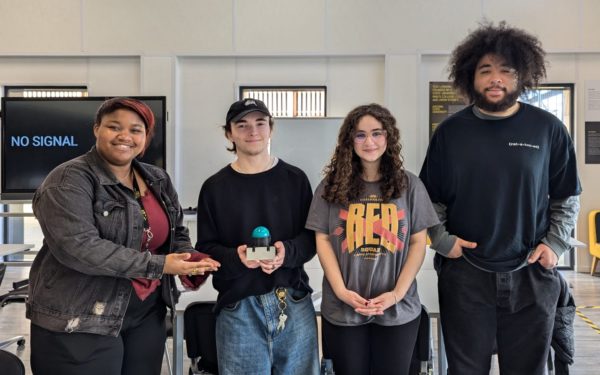
How do engineers identify and solve problems?

It’s no secret that engineers are problem-solvers, but what happens when the problem itself isn’t obvious, or when a particular area is facing multiple challenges that can’t all be solved with a single solution?
For one of their first-term projects, our 2022 cohort undertook the ‘Engineering for People Design Challenge’ developed by Engineers without Borders UK. Rather than presenting one problem, the project brief required our students to design a solution for one of several areas in need of development. As such, the teams carried out research to understand the struggles faced by the affected community and identify a key problem to solve. Throughout solution development, the teams also had to consider the social, ethical, and environmental impact their work might have.
This year’s challenge focused on Govan – an area in the south-west of Glasgow, Scotland. Before ideation, the students had to learn about how the historical significance of shipbuilding has shaped Govan, the experiences of refugees and people seeking asylum within the Govan community, and the importance and strength of community to people living in the Govan area.
Food
Two of our groups opted to design food-related solutions, both of which doubled as community spaces for the local people to socialise and undertake a project together. Both teams identified the reliance on food banks and lack of fresh produce as a key problem in Govan, and wanted to find ways to address this that would appeal to the local community. One of the teams proposed a large greenhouse to grow fresh produce; the space is designed with 1m doors and pathways, making it fully accessible to the disabled community in Govan. They also considered how to make the greenhouse self-sufficient; by using renewable energy sources – such as wind turbines – to power the lights and heaters, as well as designing the roof to collect rainwater for the produce inside, the solution would run sustainably.
The second group designed a vertical farming unit to be located near Govan’s food banks and food shops. The team carefully considered which materials would be used to build the unit, ensuring that it would be as sustainable and durable as possible. They also made use of vertical farming methods to optimise plant growth, including smart sensors to monitor irrigation, nutrition, and CO2 levels.
Energy
The group that focused on energy aimed to meet some of the needs of both Govan stakeholders and local community members; to develop vacant land for commercial and social spaces, as well as finding cheaper ways to generate energy. With this in mind, the team designed a synergy park on an abandoned brownfield site, featuring a running track and exercise equipment to engage the local community. As well as encouraging physical activity which improves mental and physical health, both the track and equipment use underground springs and turbines to generate electricity when used. The park also contains solar panels and wind turbines as further renewable energy sources.
Waste management
Two of the student teams wanted to improve some of the poor waste management processes currently used in Govan. The first team identified that the increasing organic matter in landfill contributes to global warming through methane emissions, and designed a structure to decompose it and convert it into energy. The first step breaks organic waste down into a nutrient rich fertiliser for growing new crops, before burning the resulting methane to power a steam turbine which generates electricity. Finally, the exhaust gases from the generator are broken down using enzymes, capturing the carbon and dissolving it into water.
The second team wanted to provide a more efficient recycling system that would be accessible to all users, dividing their household waste into metal, paper, glass, and plastic. The waste would be transported using electric trucks to four local sites, where the raw materials would be recycled and re-sold to be used for a range of purposes, such as developing filament for 3D printers. The group carefully considered which location would be most accessible for the community, as well as designing an app to educate users on the importance of disposing of household waste correctly. Not only would this solution make Govan a greener area, but would also reduce the amount of litter ending up on the streets and, in turn, infestations of pests such as rats.
Built environment
One of the groups identified a problem with the tenement housing buildings in Govan; due to the style and materials used to build the homes, along with the high ceilings featured, residents’ homes lose heat quickly, requiring them to use vast amounts of energy to keep warm. To combat this, the team designed a lightweight, triangular modular system to clad the room walls with. The team considered which materials would be both sustainable and keep the buildings warm, as well as how the product would be supported when installed on the ceiling. Thanks to the shape and design of the product, it can be quickly and easily assembled, minimising the cost of installation.
Digital
The final two groups developed digital solutions to improve Govan for its residents. Both teams identified that the refugees and asylum seekers that comprise a large proportion of the local people lack a sense of community. As such, the teams developed hubs designed to facilitate social interaction, as well as to provide education and information on local news and events. The first group included vertical farms within their hub; not only providing a project for the local community to collaborate on, but also to provide a cheaper way to access fresh produce. The hub would be jointly powered by piezoelectric flooring, which converts mechanical energy into electrical energy through floor tiles, and dynamo tubes, which gathers and converts the constant vibrational energy inside of beehives positioned nearby
The second group proposed using a shipping containers to house tablets and computers where the community can access local news and learning resources on learning English, digital skills, online banking, internet safety, and email. These can also be accessed via a free app, which is available in multiple languages and also provides information on where hubs are located, and how to reach the local emergency services. Each hub also provides free wi-fi to help the community keep up with an ever-increasing digital world in an area where internet signal is limited.
“It was great to see the range of problems that our students identified within one location, and to see them develop their understanding of how important it is to listen to the needs of end users before jumping into design ideation. Each student team also thought carefully about key contextual factors such as sustainability, local landscape, heritage, and cost – a vital skill for engineers.”
Mike Bramhall, Professorial Teaching Fellow and module co-lead
Interesting? Learn about last year’s Australia-based Engineering for People Design Challenge
More Industry partners articles


5 reasons to study general engineering
